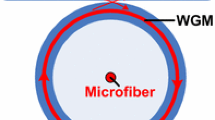Abstract
The authors develop optofluidic coupled ring resonator (OCRR) system in which one of the ring resonators serves as a microfluidic channel. Highly sensitive tuning of the OCRR is demonstrated by making small changes in the refractive index of the fluid. A refractometric sensing scheme using the OCRR is proposed and demonstrated, allowing for measuring a refractive index change down to 10−9 refractive index units, two orders of magnitude better than a single ring resonator.






Similar content being viewed by others
References
Chao CY, Guo LJ (2003) Biochemical sensors based on polymer microrings with sharp asymmetrical resonance. Appl Phys Lett 83:1527–1529
Kurt H, Citrin DS (2005) Coupled-resonator optical waveguides for biochemical sensing of nanoliter volumes of analyte in the terahertz region. Appl Phys Lett 87:241119
Levy U, Campbell K, Groisman A, Mookherjea S, Fainman Y (2006) On-chip microfluidic tuning of an optical microring resonator. Appl Phys Lett 88:111107
Maleki L, Matsko AB, Savchenkov AA, Ilchenko VS (2004) Tunable delay line with interacting whispering-gallery-mode resonators. Opt Lett 29:626–628
Mario LY, Chin MK (2008) Optical buffer with higher delay-bandwidth product in a two-ring system. Opt Express 16:1796–1807
Naweed A, Farca G, Shopova SI, Rosenberger AT (2005) Induced transparency and absorption in coupled whispering-gallery microresonators. Phys Rev A 71:043804
Paloczi GT, Scheuer J, Yariv A (2005) Compact microring-based wavelength-selective inline optical reflector. IEEE Photonics Technol Lett 17:390–392
Passaro VMN, De Leonardis F (2006) Modeling and design of a novel high-sensitivity electric field silicon-on-insulator sensor based on a whispering-gallery-mode resonator. IEEE J Selected Top Quantum Electron 12:124–133
Psaltis D, Quake SR, Yang C (2006) Developing optofluidic technology through the fusion of microfluidics and optics. Nature 442:381–386
Sandhu S, Povinelli ML, Fan S (2007) Stopping and time reversing a light pulse using dynamic loss tuning of coupled-resonator delay lines. Opt Lett 32:3333–3335
Scheuer J, Yariv A (2006) Sagnac effect in coupled-resonator slow-light waveguide structures. Phys Rev Lett 96:053901
Scheuer J, Paloczi GT, Yariv A (2005) All optically tunable wavelength-selective reflector consisting of coupled polymeric microring resonators. Appl Phys Lett 87:251102
Smith DD, Chang H, Fuller KA (2003) Whispering-gallery mode splitting in coupled microresonators. J Opt Soc Am B Opt Phys 20:1967–1974
Suter JD, White IM, Zhu H, Fan X (2007) Thermal characterization of liquid core optical ring resonator sensors. Appl Opt 46:389–396
Totsuka K, Kobayashi N, Tomita M (2007) Slow light in coupled-resonator-induced transparency. Phys Rev Lett 98:213904
White IM, Oveys H, Fan X (2006) Liquid-core optical ring-resonator sensors. Opt Lett 31:1319–1321
Xiao YF, Gaddam V, Yang L (2008) Coupled optical microcavities: an enhanced refractometric sensing configuration. Opt Express 16:12538–12543
Xu Q, Shakya J, Lipson M (2006) Direct measurement of tunable optical delays on chip analogue to electromagnetically induced transparency. Opt Express 14:6463–6468
Xu Q, Dong P, Lipson M (2007) Breaking the delay-bandwidth limit in a photonic structure. Nat Phys 3:406–410
Yanik MF, Fan S (2007) Slow light—dynamic photon storage. Nat Phys 3:372–374
Yanik MF, Suh W, Wang Z, Fan SH (2004) Stopping light in a waveguide with an all-optical analog of electromagnetically induced transparency. Phys Rev Lett 93:233903
Acknowledgments
The authors acknowledge the support from the Wallace Coulter Foundation Early Career Award and National Science Foundation-CAREER (CBET-0747398).
Author information
Authors and Affiliations
Corresponding author
Rights and permissions
About this article
Cite this article
Shopova, S.I., Sun, Y., Rosenberger, A.T. et al. Highly sensitive tuning of coupled optical ring resonators by microfluidics. Microfluid Nanofluid 6, 425–429 (2009). https://doi.org/10.1007/s10404-008-0372-7
Received:
Accepted:
Published:
Issue Date:
DOI: https://doi.org/10.1007/s10404-008-0372-7




